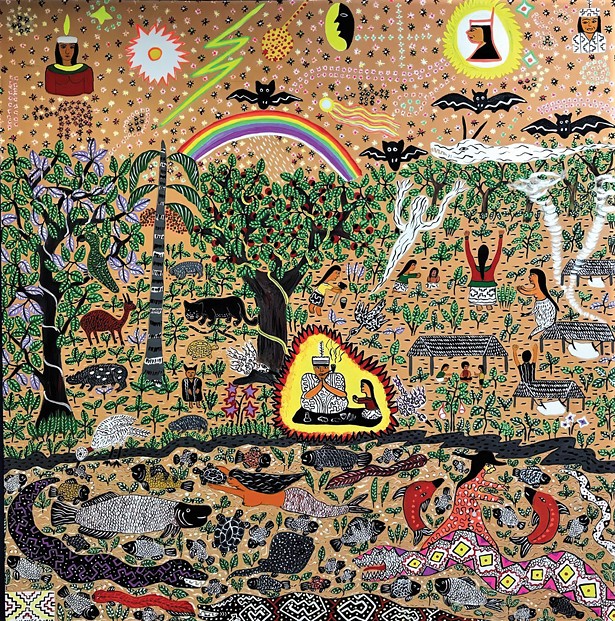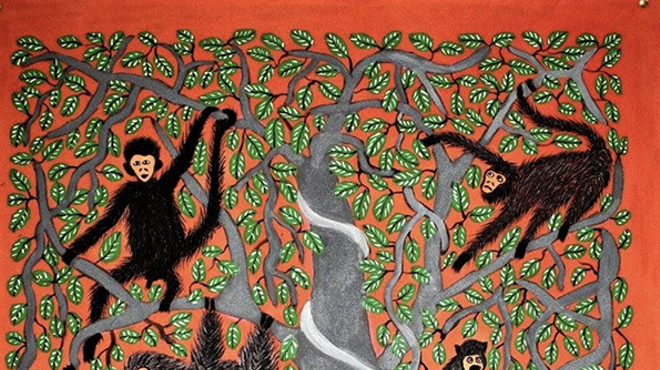On the cover this month: El Cosmovision Shipibo (Shaman and Jungle Spirits), a painting by Roldan Pinedo, one of five Shipibo-Conibo Peruvian artists whose works are currently on display at the Kingston Pop Museum as part of "Pacha Mama de la Selva" (Mother Earth of the Forest), an exhibit centered on the sacred bond that all of humanity shares with the rainforest.
Born to the Shipibo-Conibo indigenous community of San Francisco de Yarinacocha, Ucayali, Peru in 1971, Pinedo's Shipibo name is Shoyan Sheca (Restless Mouse.) His style and content are entwined with the living environment and cultural heritage of his Shipibo people. Utilizing the traditional Shipibo-Conibo geometric design patterns known as kene, Pinedo's dynamic works, infused with Amazonian flora and fauna, carry within them spirit energy and visionary insights associated with ceremonial plant medicine.
"It's pretty much just life in the rainforest, depicting the four worlds of the Shipibo cosmovision," says Callan Schanz, the traveler whose virtual gallery, El Crocodrilo Negro, partnered with Kingston Pop to present the exhibit. "It's a typical day: the women are planting ayahuasca, you can see the sacred pink dolphin, the jaguar, the snakes, the turtles, the piranha. The tree at the center is Huayruro. Its red and black seeds are the 'evil eye of the jungle'—it's considered very powerful protection. And beneath it, you see the maestro in the center, doing a ceremony with a little girl—she's probably his granddaughter, and he's teaching her."
Schanz was already a seasoned traveler and student of Indigenous healing in 2014 when he found himself headed into the Amazon. "I was doing my morning meditation in my Peekskill apartment. I closed my eyes, the walls fell away like a shoebox unfolding, and a big spiral wormhole appeared from my solar plexus."
On the other side of the wormhole he met an elderly woman who told him to come to Peru and find her. Through concerted effort and a series of serendipitous encounters, he made it to Lima and then to a village in the sacred valley of Cuzco, made contact with the right person, and was invited into the rainforest on a journey of healing and discovery that culminated in his deep connection to people he now considers family and the founding of a fair trade business bringing Indigenous art to the wider world.
"The people there are stewards for the healing of the rest of the world," Schanz says. "The energetic center was once the Himalayas; in 2012, the Mayan elders gathered and took that Kundalini—that energy—to the jungles of Peru. There's enormous pressure there. The rainforest is under threat from so many directions—the standard capitalists who want the land for mineral extraction and agriculture, the people who are building 'healing centers' for Ayahuasca tourists, the Mennonites who are starting colonies there. Even the people who want to go there because they love it, they're loving it to death. And a lot of the aid that comes from the government for these people comes with the very high cost of giving up jurisdiction over their homes."
Proceeds from Schanz's company, Patchwork Progress, and his virtual gallery, El Cocodrilo Negro, put food on the table for about 70 people. "It's a huge, difficult dance," he says. "Just in the time I've been going there, I see the encroachment of tourism and globalization. I've been initiated into crucial practices by my family, and the primary objective is to defend the sacred. The message is, we are all healers—you are your own healer."
"Pacha Mama de la Selva" will be on view at the Kingston Pop Museum through October 12. Hours are Thursday through Saturday, 6-10pm; admission is by donation. Kingstonpopmuseum.com.











